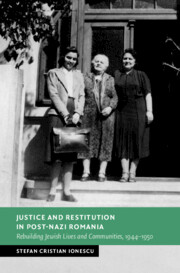Refine search
Actions for selected content:
81 results
Restitution of colonial heritage collections: Partial norm implementation in Belgium and the United Kingdom
-
- Journal:
- Review of International Studies , First View
- Published online by Cambridge University Press:
- 15 August 2025, pp. 1-20
-
- Article
-
- You have access
- Open access
- HTML
- Export citation
18 - Remedies
- from Part IV - Liability and Evidence
-
-
- Book:
- The Cambridge Handbook on Climate Litigation
- Published online:
- 03 June 2025
- Print publication:
- 31 July 2025, pp 445-471
-
- Chapter
-
- You have access
- Open access
- HTML
- Export citation
COUNTERFACTUALS IN UNJUST ENRICHMENT
-
- Journal:
- The Cambridge Law Journal , First View
- Published online by Cambridge University Press:
- 14 July 2025, pp. 1-26
-
- Article
-
- You have access
- Open access
- HTML
- Export citation
6 - The Plunder and the Restoration of Art and Cultural Property
- from Part I - History
-
-
- Book:
- The Cambridge History of the Holocaust
- Published online:
- 16 May 2025
- Print publication:
- 12 June 2025, pp 142-165
-
- Chapter
- Export citation
7 - Restitution and Reparations
- from Part I - History
-
-
- Book:
- The Cambridge History of the Holocaust
- Published online:
- 16 May 2025
- Print publication:
- 12 June 2025, pp 166-187
-
- Chapter
- Export citation
15 - In Search of Global Justice: Holocaust, Genocide, Law
- from Part III - Culture and Ideas
-
-
- Book:
- The Cambridge History of the Holocaust
- Published online:
- 16 May 2025
- Print publication:
- 12 June 2025, pp 353-373
-
- Chapter
- Export citation
9 - Archiving the Holocaust
-
-
- Book:
- The Cambridge History of the Holocaust
- Published online:
- 16 May 2025
- Print publication:
- 12 June 2025, pp 174-197
-
- Chapter
- Export citation
Title 9 - Reparation of Human Rights Violations
- from Part IV - Remedies and Implementation of International Human Rights Decisions
-
- Book:
- International Human Rights Law
- Published online:
- 10 April 2025
- Print publication:
- 01 May 2025, pp 1069-1126
-
- Chapter
- Export citation
Part IV - Remedies and Implementation of International Human Rights Decisions
-
- Book:
- International Human Rights Law
- Published online:
- 10 April 2025
- Print publication:
- 01 May 2025, pp 1067-1068
-
- Chapter
- Export citation
35 - The Principle of Full Reparation
- from Title 9 - Reparation of Human Rights Violations
-
- Book:
- International Human Rights Law
- Published online:
- 10 April 2025
- Print publication:
- 01 May 2025, pp 1071-1090
-
- Chapter
- Export citation
7 - Reparations for Victims of Grand Corruption
- from Part II - Putting Victims at the Center of Anti-Corruption Work
-
- Book:
- Fighting Grand Corruption
- Published online:
- 03 April 2025
- Print publication:
- 10 April 2025, pp 128-158
-
- Chapter
- Export citation
9 - Global Material Culture in Early Modern and Modern Europe
-
-
- Book:
- Globalizing Europe
- Published online:
- 06 March 2025
- Print publication:
- 13 March 2025, pp 123-137
-
- Chapter
- Export citation
ESCALATING GROUND RENTS IN RESIDENTIAL LEASES AND CONSUMER PROTECTION
-
- Journal:
- The Cambridge Law Journal / Volume 84 / Issue 1 / March 2025
- Published online by Cambridge University Press:
- 20 February 2025, pp. 51-78
- Print publication:
- March 2025
-
- Article
-
- You have access
- Open access
- HTML
- Export citation

Justice and Restitution in Post-Nazi Romania
- Rebuilding Jewish Lives and Communities, 1944–1950
-
- Published online:
- 06 January 2025
- Print publication:
- 09 January 2025
Distorting history in the restitution debate. Dan Hicks’s The Brutish Museums and fact and fiction in Benin historiography
-
- Journal:
- International Journal of Cultural Property / Volume 31 / Issue 2 / May 2024
- Published online by Cambridge University Press:
- 16 December 2024, pp. 202-225
-
- Article
-
- You have access
- Open access
- HTML
- Export citation
The Prakhon Chai Hoard Debunked: Unravelling Six Decades of Myth, Misdirection, and Misidentification
-
- Journal:
- International Journal of Cultural Property / Volume 31 / Issue 2 / May 2024
- Published online by Cambridge University Press:
- 12 December 2024, pp. 177-201
-
- Article
-
- You have access
- Open access
- HTML
- Export citation
11 - Victims, Witnesses, Plaintiffs
- from Part IV - A Lost Homeland: 1930–2000
-
- Book:
- Germany through Jewish Eyes
- Published online:
- 14 November 2024
- Print publication:
- 21 November 2024, pp 183-202
-
- Chapter
- Export citation
17 - Accounts of profit and disgorgement
- from Part 5 - Account of profits and other gain-based relief for wrongs
-
- Book:
- Remedies in Australian Private Law
- Published online:
- 25 October 2024
- Print publication:
- 12 November 2024, pp 462-488
-
- Chapter
- Export citation
10 - Specific performance
- from Part 3 - Remedies compelling performance and related remedies
-
- Book:
- Remedies in Australian Private Law
- Published online:
- 25 October 2024
- Print publication:
- 12 November 2024, pp 306-341
-
- Chapter
- Export citation
18 - Personal remedies for unjust enrichment
- from Part 6 - Restitution and giving back
-
- Book:
- Remedies in Australian Private Law
- Published online:
- 25 October 2024
- Print publication:
- 12 November 2024, pp 490-503
-
- Chapter
- Export citation
